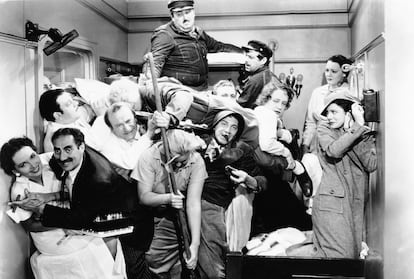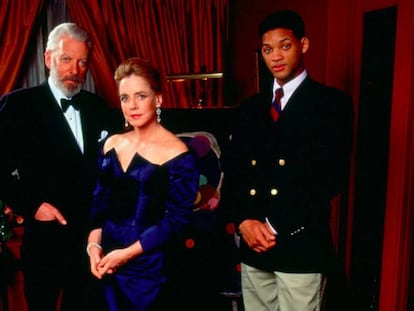How many do you think the Marx Brothers were?


As my regular readers well know, each installment of The Game of Science builds on the previous one and connects with the comments that, as I never tire of repeating—and thanking you for—make this section more than just a collection of logic-mathematical puzzles. But on this occasion, and without setting a precedent, a brief holiday break with limited internet access forces me to bring forward this week's installment, meaning it won't be able to connect with comments that haven't yet been made. So, this time, the section will be just a collection of problems.
But why eight? Because in his wonderful recreational mathematics books, whose chapters are usually monothematic, the master Martin Gardner occasionally interjects, as if in intermission, a selection of eight or nine varied problems, and I wanted to pay him a small tribute.
And not just numerical, as the following eight problems are taken from—or inspired by—his memorable section on mathematical games in Scientific American .
- Three people named Blanco, Rubio and Moreno meet at a party and, after the usual introductions, the woman comments:
—What a coincidence that our last names are Blanco, Rubio, and Moreno, and that those are also the colors of our hair.
"That's funny," the blond person replies, "and besides, no one has the hair color that matches their last name."
"It's true!" exclaims the person named Blanco.
- If the woman is not brunette, what color is Rubio's hair? Can an obtuse triangle be divided into acute triangles? If division is possible, what is the minimum number of acute angles into which an obtuse angle can be divided?
- If you meet two of the Marx Brothers (not three, as some believe), there's a fifty-fifty chance that both are left-handed. What's the most reasonable prediction about the number of Marx Brothers and how many of them are left-handed?
- If you cut a cube along a plane parallel to any of its faces, the cross-section will obviously be a square. If you cut it along a plane passing through the center and four vertices, the cross-section will be a rectangle (what kind of rectangle, by the way?). If you cut it along a plane perpendicular to a diagonal and close to a vertex, you'll get an equilateral triangle... Can you cut a cube so that the cross-section is a regular hexagon?
- On a 3x3 grid, place the digits 1 to 9 so that the third row is the sum of the previous two and a chess rook could traverse the numbers in ascending order (starting at 1 and ending at 9) moving as this piece does (i.e. horizontally or vertically, but not diagonally).
- The great Carson McCullers wrote a play called The Square Root of Wonderful. If each letter of WONDERFUL represents a digit, all distinct and none zero, its square root is OODDF. What is that number?
- On a standard chess board , 40x40 cm, what is the radius of the largest circle that passes only through white squares?
- Two trains are traveling on the same track in opposite directions, on a collision course, one at 130 kilometers per hour and the other at 170 kilometers per hour. If their initial distance was 1,300 kilometers, how far apart will they be from each other five minutes before colliding? Try to solve this mentally.
Do you want to add another user to your subscription?
If you continue reading on this device, it will not be possible to read it on the other device.
ArrowIf you want to share your account, upgrade to Premium, so you can add another user. Each user will log in with their own email address, allowing you to personalize your experience with EL PAÍS.
Do you have a business subscription? Click here to purchase more accounts.
If you don't know who's using your account, we recommend changing your password here.
If you decide to continue sharing your account, this message will be displayed indefinitely on your device and the device of the other person using your account, affecting your reading experience. You can view the terms and conditions of the digital subscription here.

He is a writer and mathematician, a member of the New York Academy of Sciences. He has published more than 50 popular science works for adults, children, and young adults, including "Damn Physics," "Damn Mathematics," and "The Great Game." He was the screenwriter for "La bola de cristal."
EL PAÍS







